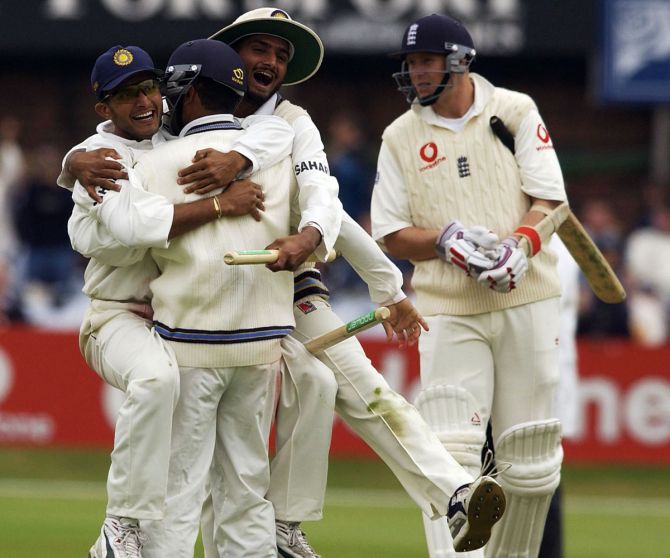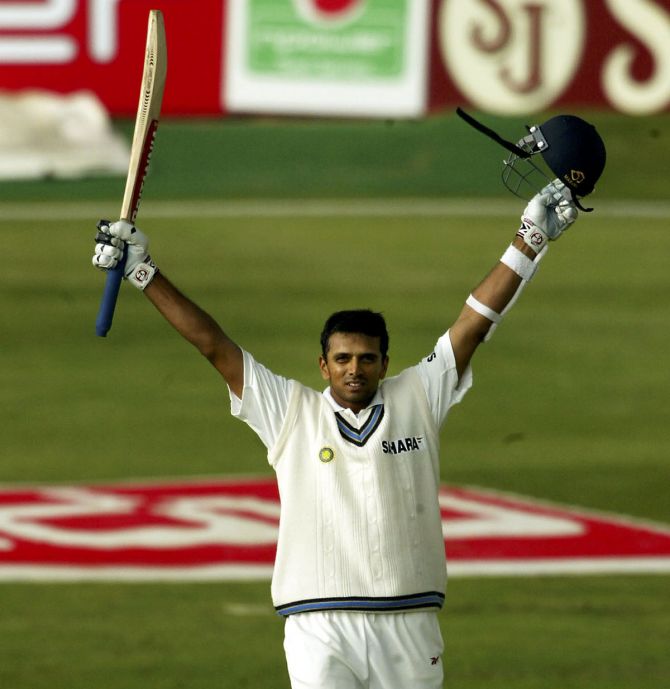 | « Back to article | Print this article |

Nineteen years ago, India, led by Sourav Ganguly, registered one of its most famous overseas wins in Test cricket, trouncing England by an innings and 46 runs at Headingley on August 26, 2002.
India's previous Test win in England, in 1986, also came at Headingley, when the Kapil Dev-led team registered a thumping 279 run victory with Dilip Vengsarkar slamming a brilliant century and a fifty -- the only batsman from both teams to go past fifty in the Test.
The third Test, which begins on Wednesday, August 25, will be the first time since the 2002 win that an Indian team will take the field for a Test at Headingley in Leeds.
Fresh from their brilliant win at Lord's, Virat Kohli and his team will look to make it a third consecutive Indian win at Headingley.
This is what happened at Headlingley on almost the same dates 19 years ago:
The Headingley Test in 2002 proved to be a major turning point for the Indian team, who were traditionally considered poor performers away from home.
A determined Ganguly seemed firm at changing India's dismal away record and it was a brave decision by the skipper to elect to bat on a greentop, having included two spinners in Anil Kumble and Harbhajan Singh.
All-rounder Sanjay Bangar was included as the opener in place of Wasim Jaffer, with the additional responsibility of bowling some overs as the third seamer.
'After long meetings, attended by senior players and the coaching staff before the match, Sourav Ganguly decided to bat first and play both spinners. Despite the consultations, it was the captain's decision, for he has the final word and inevitably carries the can,' the late Peter Roebuck said in his column for Rediff.com in 2002.
'Spinners had not taken wickets at Headingley since The Beatles were top of the charts, and most visiting teams put them in a cupboard for the duration of the match. No English tweaker had removed an opponent since Michael Atherton trapped Wasim Akram in front; and that was a dodgy decision, too.'
'By naming both slow bowlers, India defied history. But the selection sent out a message to the home team: India was going to play to its strengths. Ganguly's team knew one method of winning matches and was going to pursue it till the Hoogly freezed over.'

The start on Day 1 was not ideal as Virender Sehwag fell early, caught at second slip off Matthew Hoggard for eight.
Bangar and Rahul Dravid battled hard for the rest of the morning session, with saw 11 maidens in the 28-over opening session.
Bangar and Dravid kept the England seamers at bay in the post-lunch session also as they put on 170 runs for the second wicket.
"To be honest, we did not talk too much during that innings. We could sense the frustration of the England bowlers who were expecting to roll us over pretty quickly in those seaming conditions. It was about ugly batting in the sense that you played the line, got beaten by late swing, but survived because you did not throw hard hands at the ball," Bangar told this correspondent last year.
Bangar was dismissed caught behind for 68 and he had repaid the faith shown by the team management in him. But there was no moving Dravid, who started off cautiously before delighting the crowd with his quality stroke-play on a lively wicket.
He reached his second successive century of the series in the post-tea session as India dominated the opening day to reach 237/2 at stumps.

India consolidated their position on the second day with Sachin Tendulkar and Sourav Ganguly also slamming centuries.
Dravid was stumped off Ashley Giles after a wonderful innings of 148, having put on 170 runs for the third wicket with Tendulkar.
But there was no stopping Tendulkar and Ganguly as the duo went after the England bowlers. Ganguly brought up his third consecutive half-century of the series by slamming Giles for the first six of the match. The ball smacked a spectator, attempting to catch the ball, bang on his forehead.

Tendulkar smashed his way to a brilliant 193 -- his 30th Test century, hitting 19 fours and three sixes, while Ganguly hit 128, with 14 fours and three sixes, as the duo put on 249 runs for the fourth wicket -- the third best fourth-wicket stand ever at Headingley by an Indian pair, erasing the 222 run partnership between Vijay Hazare and Vijay Manjrekar, set in 1952.
Tendulkar was contemptuous of the English seamers, hooking and pulling at will, while Ganguly devastated the hosts with his sublime strokes through the off-side, and sweep slogs over the mid-wicket fence.
The highlight of the day was Ganguly's attack on Giles, hitting the spinner for 4,6,6,4 in the 171st over before he was bowled by pacer Alex Tudor.

India continued to bat on the third day as they piled on the runs.
Tendulkar missed his double century by seven runs, dismissed leg before wicket by Andrew Caddick and India lost regular wickets thereafter as the batsmen looked for quick runs.
India piled on a mammoth 628/8 declared in their first innings, and England's batsmen seemed to succumb under the pressure of the huge total.
For England, only Michael Vaughan (61) and Alec Stewart (78 not out) could go past the 50-run mark as the hosts were bundled out for 273 in the first innings before Ganguly promptly enforced the follow-on on the fourth day.
India's decision to play two spinners was vindicated as Harbhajan and Kumble picked up three wickets each to run through the England middle and lower order, while pacers Zaheer Khan and Ajit Agarkar bagged two wickets apiece.
England fared no better in their second innings. Captain Nasser Hussain hit 110 but got no support from the other batsmen. With both skippers -- Sourav Ganguly (128) and Naseer Hussain (110) -- scoring hundreds in the match, it provided the third such instance in a Test between the two sides.

The Test will also be remembered for Andrew Flintoff's no show with the bat as he became the first Englishman to bag a pair at home against India.
Flintoff, on a pair in the second innings, was greeted with a bouncer by Zaheer. Words were exchanged before Flintoff edged the next delivery to Dravid at first slip to register his fourth duck at Headingley in as many innings.
Kumble took 4/66, while Bangar proved his utility with the ball to take 2/54 as England were sent packing for 309 in their second innings in the morning session on the fifth day, to suffer one of their worst defeats in Test cricket.

The 12 wickets captured by spinners Kumble (7), Harbhajan (4) and Giles (1) in the Test was the maximum taken by spinners at Headlingley in 25 Tests since 1975.
The victory was then only India's second away from home since defeating Australia at Sydney in 1977-1978.
The win by an innings and 46 runs was India's best in an away Test match bettering their previous best win of an innings and two runs against Australia at Sydney in January 1978.
It was also India's best win against England surpassing the innings and 22 run victory at Madras in January 1993.
Dravid was named as the man-of-the-match for his brilliant century on the first day of the Test, in conditions that were anything but conducive for batting.

Kumble, who went on coach the Indian team, picked the 2002 victory over England in the Headingley Test as the 'defining moment' of his career.
'The Headingley Test was a defining moment for me and Indian cricket. It continued from that, the former India captain stated India's famous victory during a talk show hosted by the Cricket Association of Bengal on the sidelines of India's 250th Test on home soil in Kolkata in 2016.
Headingley 2002 was Ganguly's fifth away win, the most by any Indian captain then. Mansur Ali Khan Pataudi and Bishan Singh Bedi had registered three away wins.
The Headlingley triumph marked the start of a new and important chapter in Indian cricket, with the Indians winning consistently away from home from that point onwards.